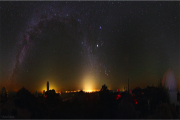 2017-01-10
2017-01-10
Artificial light at night is a threat to astronomical research, personal safety, and the health of both humans and wildlife. The problem is worsening with the proliferation of LED billboards and blue-rich white light LEDs as an option for street lighting. Within five years, LED technology will take over as the dominant type of outdoor lighting technology. With this in mind, scientists and lighting engineers say now is the time to implement strategies for reducing light pollution. By working together, they are identifying the best type of LED to use while suggesting actions that minimize intrusive lighting.
Continue reading →
 2017-01-10
2017-01-10